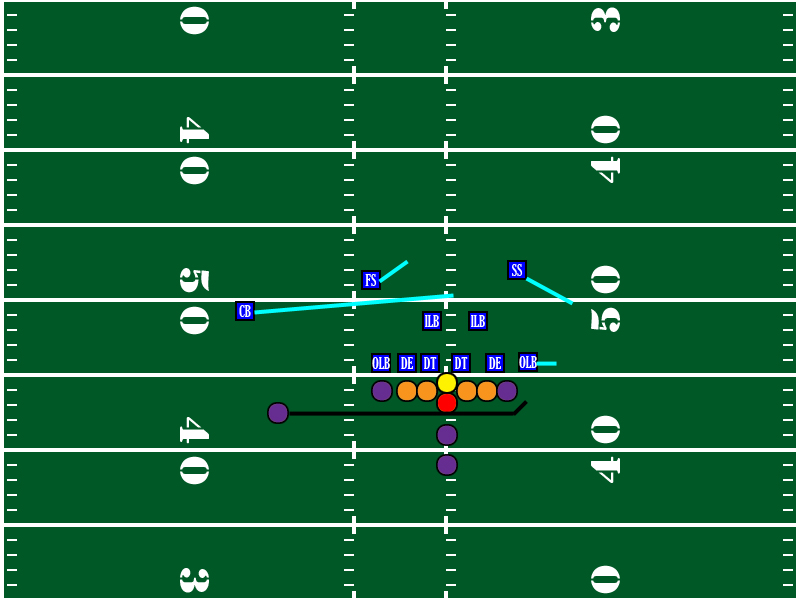
 In our eighth part of this series, we are going to take a look at the Green Bay Packers’ heavy “Hippo” defense. This formation is obviously used in short-yardage situations, particularly on third and fourth down where a running play is expected. It adds an extra lineman by sacrificing a defensive back, usually a corner.
In our eighth part of this series, we are going to take a look at the Green Bay Packers’ heavy “Hippo” defense. This formation is obviously used in short-yardage situations, particularly on third and fourth down where a running play is expected. It adds an extra lineman by sacrificing a defensive back, usually a corner.
Explaining the Formation
So far we’ve been moving towards defensive packages with more and more defensive backs. With the Hippo defense, we are going to do a complete 180-degree turn and look at a personnel grouping with only three defensive backs. The Hippo is a 4-4-3 defense that aims to get more big bodies along the line of scrimmage to block up running lanes.
The front line of this heavy defense consists of two defensive tackles, two defensive ends, and two outside linebackers. That’s some serious beef for the offensive line to try to move. Behind them are the inside linebackers, and in the secondary are two safeties and a cornerback.
Without getting into any sort of complicated player technique and tactics, the primary goal of the front six is to disrupt the blocking lanes and prevent the offensive linemen and tight ends from getting to the second level. These guys are going to get as low as possible to control the point of attack and, in many cases, simply take out the legs of the opposition.
The inside linebackers and safeties are, in essence, the clean-up crew. They flow towards the ball and continue to clog up any running lanes left behind by the line. Their reaction has to be quick and their angles sure in order to get to the running back and make a successful stop. Let the ball carrier get past the linemen, and it’s probably going to end up being a conversion.
Obviously, the defensive assignments can vary depending on the tendencies of the opposing offense. The threat of a pass could tie up the cornerback and one of the safeties, preventing them from helping in run support. At that point, it’s up to the defensive coordinator and players to rely on their film study and opposition scouting to make the right call.
The Hippo Defense in Action
Today we’re taking you all the way back to Week 1 of 2012 when the Packers got their first whooping from the San Francisco 49ers. There’s only 1:05 left in the second quarter, and the 49ers are on the Packers 25-yard line. It’s 3rd-and-1, so a successful conversion not only gets them more chances to reach the end zone, but it takes time away from the Packers to answer before the half ends.
Breaking Down the Play
The 49ers trot out in a 23 personnel grouping (2 RB–3 TE–0 WR), signaling an obvious power running play. In fact, the fullback is being played by DE/FB Will Tukuafu who has reported in as eligible. Also reporting as eligible is G Leonard Davis who plays the strong side tight end. Vernon Davis is the inline tight end on the weak side, and Delanie Walker is the split end. So, in reality, there are six offensive linemen, two tight ends, a running back, and a defensive end playing fullback.
If that doesn’t scream “power run,” then I don’t know what does.
To counter this, Dom Capers sends out his Hippo package. Along the line of scrimmage, from left to right, are Clay Matthews, Jerel Worthy, B.J. Raji, Ryan Picket, Philip Merling, and Nick Perry. The inside linebackers are A.J. Hawk and D.J. Smith, while the secondary consists of Tramon Williams, Morgan Burnett, and Charles Woodson.
Here’s what the setup looks like before the pre-snap motion by the tight end:
Tramon Williams follows the tight end (Walker) as he goes in motion to a wingback position, while the safeties rotate toward the strong side. You’ll note in the video Charles Woodson motioning for Burnett and Williams to hurry up and get in close for the run. As we’ve seen before, motioning a single player can sometimes disrupt a defense enough to create problems.
But despite the secondary being caught in the middle of their transition, here’s what happens at the snap:
As could be expected, the 49ers run a Power-O with the offensive line down blocking. The fullback leads to block the end lineman (Nick Perry in this case) while the left guard is pulled to further seal off the running lane. Unfortunately for the 49ers, no one accounts for A.J. Hawk, who gets a pretty clean line at the running back. Charles Woodson also skirts around the edge and gets to Frank Gore at about the same time, helping with the tackle.
Defending a Power-O really relies on the second level defenders filling the running lane to make the stop, and that’s exactly what the Packers are able to do. With Merling double-teamed and the left guard missing Hawk, the 49ers simply became out-numbered.
The chaotic nature of these power running plays can make them a little hard to follow on first sight, especially when the defense is loading the line with a heavy package like the Hippo. Hopefully the video and diagram gave you a better understanding of what’s happening in this situation.
——————Chad Toporski, a Wisconsin native and current Pittsburgh resident, is a writer for AllGreenBayPackers.com. You can follow Chad on twitter at @ChadToporski
Follow @ChadToporski——————



See, AJ Hawk does make some plays!!
Damn we got our asses kicked last year by the niners. Is this D better this year? We shall soon find out.
Walker was flanker not split end ;p